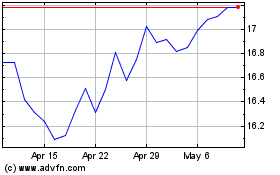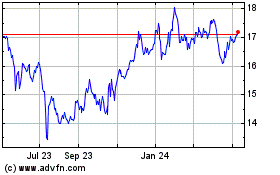By Drew FitzGerald and Sarah Krouse
U.S. wireless companies' limited access to some of the nation's
most valuable airwaves threatens to slow down their plans to build
faster 5G networks.
At issue are broad swaths of the radio spectrum in frequencies
that can travel long distances and penetrate buildings. This
"mid-band" is considered ideal for faster, fifth-generation
wireless service.
"Mid-band is in the sweet spot in terms of what's most valuable
to wireless operators," said Walt Piecyk, an analyst at investment
bank BTIG, in part because carriers can deploy those frequencies
atop existing cell towers, rather than blanketing neighborhoods
with hundreds or thousands of new antennas. While U.S. officials
take their time making mid-band airwaves available to carriers, he
said, " a lot of countries are auctioning off that spectrum."
Sprint Corp. and Dish Network Corp. already hold large amounts
of mid-band spectrum not yet put to work serving customers. Other
nearby frequencies remain reserved for satellite communications and
military use in the U.S..
Telecom companies have spent more than $25 billion over the past
three years to snap up wireless-airwave licenses beyond the
mid-band range, targeting both high and low extremes considered
useful for carrying wireless data.
Verizon Communications Inc. and AT&T Inc. have launched 5G
services in a few cities using high-frequency millimeter wave
spectrum that provides ultrafast speeds but can't travel long
distances and is limited in its ability to penetrate hard materials
like walls.
AT&T promises to offer nationwide 5G in the first half of
2020 over spectrum licenses it already controls. Company technology
chief Andre Fuetsch said more mid-band spectrum under FCC
consideration "would help round out our current holdings" and speed
up that 5G expansion.
The Federal Communications Commission unveiled a plan Tuesday to
commercialize licenses in the Educational Broadband Service. The
service was created in the 1960s for use by educational groups for
instructional television, and some licenses are now used for
wireless broadband systems for school districts.
Some of the airwaves, which are above 2.5 gigahertz and often
lumped in with mid-band spectrum, are used by federally recognized
Native American tribes in rural areas of the U.S.
The FCC's plan aims to make available to wireless companies and
other businesses some unused or underused swaths of that spectrum.
Schools that currently use some airwaves can continue to use their
licenses, expand that use or sell them, a senior FCC official said.
Tribal groups also would receive priority access and, after that,
unused airwaves would be auctioned off.
WISPA, a trade body for fixed wireless broadband companies, said
the move would expand broadband coverage, including in rural
areas.
Mariel Triggs, chief executive of Mural Net, an organization
that is building a wireless network to serve the Havasupai tribe in
the Grand Canyon, called the move "a major step forward in the
effort to close the digital divide in rural America, especially for
Indian Country."
Some educational groups oppose commercializing airwaves long
reserved for schools. Taking away educational groups' priority
status would be "disastrous for online learning, 5G deployment and
rural consumers," said Alicja Johnson, a spokeswoman for the
Schools, Health & Libraries Broadband Coalition.
Even with the FCC's efforts, agency officials cautioned the new
rules would take time to implement. New mid-band auctions won't
start until after the commission finishes selling more
millimeter-wave licenses at the end of this year.
Executives of T-Mobile US Inc. and Sprint have seized on delays
in making spectrum available to argue for approval of their more
than $26 billion merger. The companies say joining forces would
save them billions of dollars each year that could be invested in
new equipment that uses Sprint's 2.5 gigahertz licenses.
"Here in the U.S., we have this mid-band dilemma," T-Mobile
technology chief Neville Ray said in an April conference call with
analysts. "We can solve that."
But T-Mobile's plan to cover rural areas using Sprint spectrum
also faces obstacles. A group of state attorneys general sued last
week to block the merger, arguing the arrangement would raise
prices for cellphone service, especially among low-cost plans. The
Justice Department hasn't issued a public decision on the proposed
merger.
Other wireless industry experts cite opportunities above 3.5
gigahertz, where several other countries have marked frequencies
for 5G use. Those frequencies, too, are tied up by competing
interests in the U.S.
The Citizens Band Radio Service is a cluster of radio channels
that offers companies or individuals access to frequencies above
3.5 gigahertz, provided they register their use with an online
system designed to prevent them from interfering with Navy radar
signals.
Nearby on the spectrum, TV broadcasters, cable companies and
other users receive satellite signals on the C-Band. A coalition of
satellite companies called the C-Band Alliance floated a plan last
week to squeeze those satellite customers into a narrower band that
makes room for cellphone companies willing to pay billions of
dollars for desirable spectrum.
That plan, too, would take months to put spectrum on the market
but is still the quickest option available to avoid cutting off
customers who run the gamut from cable-TV providers to Mormon
churches, according to C-Band Alliance vice president Peter
Pitsch.
"We're under contract to a lot of those folks," Mr. Pitsch said.
"We want to keep good faith with them, keep them whole."
Verizon CEO Hans Vestberg met last week with FCC Chairman Ajit
Pai and another agency official to ask the commission to make more
mid-band spectrum available, according to a regulatory filing. The
largest U.S. carrier told regulators that mid-band spectrum would
help achieve broader coverage.
"We're interested in getting as much spectrum in the marketplace
as possible," Craig Silliman, Verizon's general counsel, told
analysts Tuesday.
Write to Drew FitzGerald at andrew.fitzgerald@wsj.com and Sarah
Krouse at sarah.krouse@wsj.com
(END) Dow Jones Newswires
June 20, 2019 10:04 ET (14:04 GMT)
Copyright (c) 2019 Dow Jones & Company, Inc.
AT&T (NYSE:T)
Historical Stock Chart
From Mar 2024 to Apr 2024

AT&T (NYSE:T)
Historical Stock Chart
From Apr 2023 to Apr 2024
